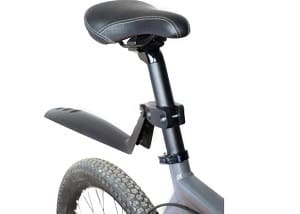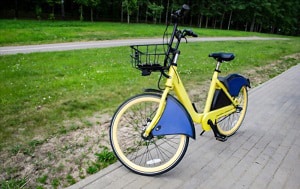If you have ridden bicycles with fenders before, you may wonder, “Are they just there because they look cool?” or “Do they protect us from something serious?”
On the off chance that it rains, fenders are here to help you ride in wet weather. They enable you to stay drier and avoid splashes from wet roads.
Read more for an in-depth explanation of what are bike fenders for.
Table of Contents
What Do Bike Fenders Do?
A fender on a bike is a flexible, curved piece of metal or plastic that mounts to the wheels of your bicycle. It extends from the frame of your two-wheeler and curves outwards, serving as a protective barrier.
Going straight to the point, bike fenders purpose is to shield the rider from debris and prevent water from hitting their face and body.
A bicycle rain fender, also known as a mudguard, can be equipped at the front wheel, the rear wheel, or both. As a result, we have two basic types of bicycle fenders:
- A bicycle front fender stops water from splashing up and hitting you in the face, arms, and knees.
- A bike back fender deflects water away from your legs and back.
Both types offer additional safety benefits during wet weather rides.
Apart from that, fenders can also be distinguished by how they are attached to your two-wheeler. The most common attachments are:
1. Quick Release
This allows you to attach and remove the fenders very quickly, which is convenient when you are in a hurry. Quick-release add-ons are usually designed with velcro or clips, so you can use them even without eyelets.
2. Bolt-on
This type requires more effort to remove but is generally stronger than quick-release designs due to the way they are attached. You may have seen a full set of non quick-release fenders that needs to be bolted onto your bike frame.
3. Saddle Mounted or Mudder
Also called an ass-saver, this is one of the easiest fenders to mount but offers the least protection due to its small size and shape. You will also find a front version of this, called the face-saver.
Advantages and Disadvantages
Even though fenders sound like a nice addition to your bike, there are still pros and cons that you should consider before you fit bicycle mudguards.
- Protects the rider from splashes. When water or mud splashes against the wheel, there is a big chance that it can land on your body and make you feel dirty.
- Protects the bike frame from wear and tear. Your body is not the only thing a fender protects. Your bike will also be shielded from mud and grime that cause wear and tear.
- Reduce Aerodynamic drag. Full coverage mudguards or those with 135° coverage can reduce the aerodynamic drag, based on a study conducted by the SAE in 2019.
- Cool Design Element. These attachments can also make your two-wheelers look cool or elegant, depending on the design that you prefer. Customized fenders are also a thing for bike enthusiasts who like to mix and match colors.
- Extra weight. A bicycle with fenders is not common in the racing scene due to the added weight that they bring, especially metal ones.
- It can jam your wheels. If you are riding off-road, rocks and other obstacles can get caught in your fender and jam your wheel. Although quality mudguards have a quick-release mechanism to pull themselves away, others do not, and this is dangerous when you are riding.
- Mounting for beginners can be challenging. If you are not familiar with the mounting of your fender and did not check its compatibility with your bicycle, then you may have a problem. Bikes can handle full fenders only if they have clearance between the wheels and the frame.
Frequently Asked Questions
1. How to Check Bike Fender Sizes?
Mudguards come in various shapes and sizes so that they can fit most bikes. Before buying a fender, you should check these measurements:
- Frame clearance – There should be enough distance between your wheels and the frame for the fender to fit (around 10 to 15 mm).
- Wheel radius and width – You must pick a compatible fender that is at least 8mm wider than your tire for maximum coverage.
Moreover, make sure the mudguard is compatible with your tire radius. Some products are adjustable to fit different wheels (from 24-29 inches, for instance).
Taking measurements ensures you can use the mudguard you want as some are designed specifically as road bike rain fenders or BMX fenders.
2. Do I Really Need Fenders on My Bike?
If you are thinking “Are bike fenders worth it?”, you must first consider the terrain and the weather that you commonly experience in your location.
Is the ground muddy? Does your city have frequent rains? Or are puddles and rocks common on the road?
These questions will help ascertain if you really need fenders. There is also no harm in trying a front fender bicycle first or quick-release mudguards as a trial and see if they fit your cycling needs.
We recommend getting some fenders if you’re going to be riding in wet weather any time soon — especially if you reside in a rainy city like Seattle!
3. Why Do Most Bikes Not Have Fenders?
Some cyclists prefer no fenders on bikes, especially if they opt for off-roading or racing. In fact, fenders do not help the rider’s safety in such events, so it is better to just leave them out.
Since they are bike attachments, most manufacturers also think that they do not need to be installed upon production. If the riders want to mount a fender, then they can do it by themselves or through a professional.
There are also bicycle designs without eyelets, and they are incompatible with many mudguards.
If you want to install fenders on a bike with disc brakes, it will be more difficult because such a vehicle usually has no caliper bolt to attach to the fender.
4. Do I Need Fenders on My E-bike?
Our answer is yes! Unlike traditional bicycles, electronic bikes have a lot of sensitive components like batteries and electronics that are necessary to keep them moving.
Getting some extra protection from water, grime, and rocks through fenders is a great way to maintain your e-bike.
Conclusion
Fenders are necessary for your bicycle if it is ridden on wet or dirty roads. It is a useful accessory if you understand its worth!
No need to research what are bike fenders for. To sum up this article, bike fenders are great equipment for the cleanliness and protection of your bicycle and you as a rider.

“I ride my bike to work for years, but is that enough? Our carelessness towards our surroundings has taken a toll on the environment. And now, everyone is responsible for changes; even the most minor contribution is counted. With this hope and spirit, I started with my partner to establish Biketoworkday to help more individuals commute to their work sites on their bikes.”






